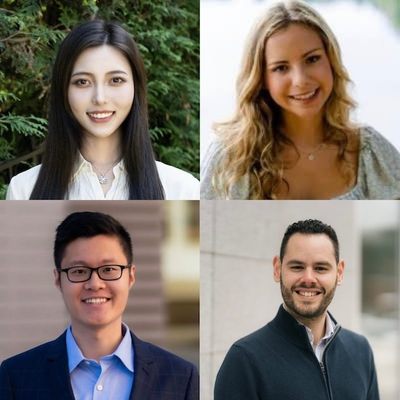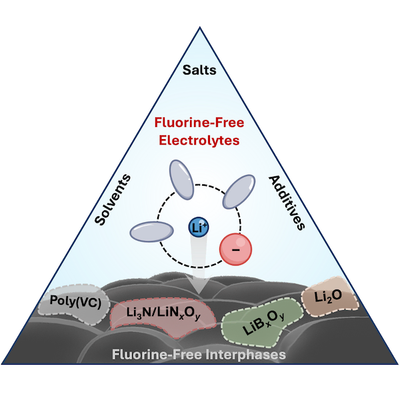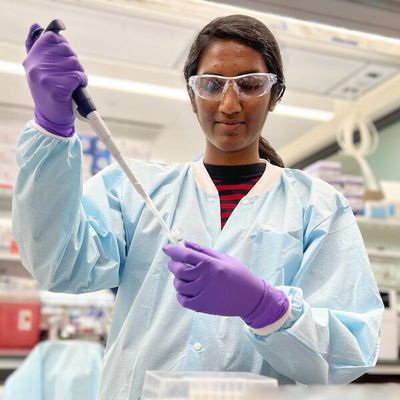- Undergraduate
Bachelor's Degrees
Bachelor of ArtsBachelor of EngineeringDual-Degree ProgramUndergraduate AdmissionsUndergraduate Experience
- Graduate
Graduate Experience
- Research
- Entrepreneurship
- Community
- About
-
Search
Research Quick Takes

Dec 11, 2025
Guide for Generating Spatial Data
PhD student Ruixu (Rachel) Huang is a co-lead author of "Systematic benchmarking of imaging spatial transcriptomics platforms in FFPE tissues" published in Nature Communications. A collaboration between the Goods Lab and the Broad Institute of MIT and Harvard, the study is the first to compare commercial platforms for generating spatial data.

Dec 04, 2025
Better Printed Solar Cells
Postdoc Yanan Li, PhD students Julia Huddy and Masha Klymenko, and Professor Will Scheideler coauthored "Spatial-Uniformity–Driven Bayesian Optimization for Rapid Development of Printed Perovskite Solar Cells" published in Small. (This came out of work recently funded by DOE in Scheideler's SENSE Lab.) "Metal halide perovskites are a promising emerging solar technology, but challenges in reliability and large‑area scalability still hinder widescale adoption. This work uses a machine‑learning–driven Bayesian optimization approach to improve the uniformity of printed perovskite films—addressing a key bottleneck for scaling low‑cost, roll‑to‑roll manufacturing and enabling higher‑efficiency, more reliable solar cells," said Scheideler.

Nov 20, 2025
Toward Optimal Auctions
PhD student Mai Pham, will present her paper, coauthored with professors Vikrant Vaze and Peter Chin, titled "Advancing Differentiable Mechanism Design: Neural architectures for combinatorial auctions" for a workshop at the Conference on Neural Information Processing Systems. Although auctions are considered an effective way of allocating limited resources when demand is high, designing auctions that are simultaneously optimal for the participants, system operator, and greater society is challenging. The paper presents a new approach that leverages modern deep learning architectures and algorithms to meet this challenge.

Nov 20, 2025
TERMIS-AM Conference Winner
Postdoctoral Research Fellow and Founder and CEO of NovaGyn Becca Thomson '20 Th'21 Th'25 attended the Tissue Engineering and Regenerative Medicine International Society Americas Conference in Detroit. There she was a finalist in the Business Plan Competition and winner of the $1,000 People's Choice Award and $2,000 Judges' Award. "Winning these awards was an incredible honor and a huge validation for NovaGyn's mission of advancing surgical solutions in women's health," said Thomson. "I'm thrilled that our innovative approach to tissue engineering resonated with both experts and the community. This recognition motivates us to continue pushing the boundaries of regenerative medicine and bring meaningful solutions to patients worldwide."

Nov 13, 2025
Research Startup Showcase
Postdoc researcher Yanqiao Li Th'25, advised by Professor Jason Stauth, presented his startup, uDrive, at The Engine's Blueprint Showcase in Boston—the culmination of a program that helps researchers build "tough tech" startups. Leveraging Li's PhD research at Thayer, uDrive develops technologies for next-generation haptics and compact cooling solutions for mobile devices. Smartphones currently use basic haptics [vibrations] for notifications," Li explained. "High-definition haptics, enabled by new piezoelectric actuators, can do much more—such as allowing you to feel the texture of clothes while shopping online. The widespread adoption of this technology, however, is currently limited by a lack of high-voltage, energy-efficient electronics. Our startup is bridging this gap."

Nov 13, 2025
Measuring Human-AI Trust
PhD student Bruno Miranda Henrique gave a presentation that won the research award for the graduate division in math and computer science at this year's International Forum on Research Excellence (IFoRE) by Sigma Xi. His research, titled "Dynamic Trust Calibration Using Contextual Bandits," addresses the need for a definitive and objective method for measuring trust between humans and AI. "Our indicator dynamically assesses when to trust AI contributions based on learned contextual information," reads the abstract. "These findings not only enhance theoretical understanding but also provide practical guidance for developing more trustworthy AI systems supporting decisions in critical domains, for example, disease diagnoses and criminal justice."

Nov 06, 2025
Advancing Space Science
Professor Jacob Buffo gave a video presentation about his recently completed Planetary Society "Science and Technology Empowered by the Public" (STEP) grant project. Buffo and his team investigated "Multiscale Characterization of Brine-Rich Planetary Analog Environments," with the goal of helping to optimize site selection for planetary and astrobiology missions.

Oct 30, 2025
Co-Designing Education
Professor Rafe Steinhauer authored "Improving Public Schools by Co-Design," published in the inaugural issue of Dartmouth's Social Impact Review. The article centers on Steinhauer's unique approach to combining design and education. "Our program [Upper Valley Education Design Clinic] prioritizes co-design. Together, district teams and undergraduate students [ENGS 15.11: Design and Education] learn design thinking ... This is an exciting model for town-gown partnership—not just universities serving schools, but higher education and K-12 communities working as co-designers of change," writes Steinhauer.

Oct 16, 2025
Predicting Nonadherence to Breast Cancer Screening
PhD student Jiahui Luo and Professor Wesley Marrero—with quantitative biomedical sciences PhD student Guofang Ma and Miranda Scully '26—co-authored "Modeling the impact of social determinants on breast cancer screening: a data-driven approach" published in Frontiers in Medicine. "The study identified opportunities for healthcare organizations to transform sociodemographic data into targeted, facility-level intervention strategies while adapting to payer incentives and addressing screening gaps," said Marrero.

Oct 09, 2025
Strategic Cyber Defense
PhD student Mai Pham and professors Vikrant Vaze and Peter Chin coauthored "Strategic Cyber Defense via Reinforcement Learning-Guided Combinatorial Auctions" which was chosen for presentation at the IEEE High Performance Extreme Computing Conference. "This work formulates the cyber defense problem, in which we act as a defense agent protecting a network from malware attackers, as a combinatorial auction," said Pham. "We combined reinforcement learning with differentiable mechanism design to find the best resource allocation for the hosts, which aims to upstream decision making and proactively protect the network."

Oct 09, 2025
Toward Greener Batteries
Research Associate Peiyu Wang Th'25, PhD students Huilin Qing and Ruiwen Zhang, and Professor Fiona Li coauthored "Fluorine-free electrolytes for sustainable lithium batteries: a review" published in npj Materials Sustainability. The paper highlights insights and advances in fluorine-free salts, solvents, additives, and interphases, along with challenges and opportunities, offering sustainable solutions potentially competitive with conventional fluorinated electrolytes. "Modern lithium battery electrolytes rely on fluorinated components to enhance performance and functionality, but such schemes raise safety, environmental, and cost concerns due to hydrogen fluoride generation and hazardous production," said Li.

Oct 02, 2025
Biology of Human Milk
Goods Lab PhD student Laasya Devi Annepureddy is co-lead author of "Integrated ‘omics analysis reveals human milk oligosaccharide biosynthesis programs in human lactocytes" published in iScience. The study reveals pathways for how breastmilk cells produce sugars that are critical to infant health and development, and paves the way for being able to add them to formula or as a supplement to certain foods. "Being part of this project has been incredibly rewarding," said Annepureddy. "Our findings bring us one step closer to understanding the remarkable biology of human milk, and I’m grateful to the outstanding team whose collaboration made this work possible."
